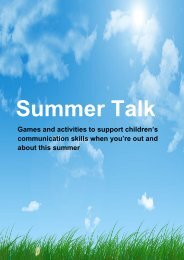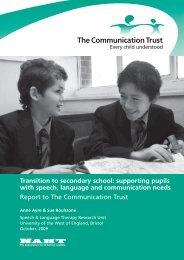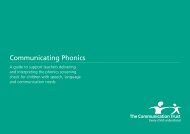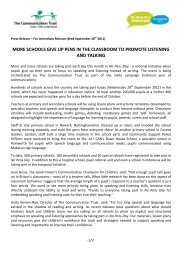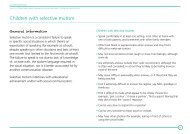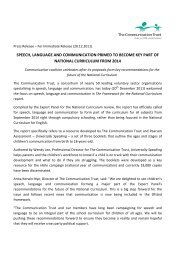A Generation Adrift - The Communication Trust
A Generation Adrift - The Communication Trust
A Generation Adrift - The Communication Trust
You also want an ePaper? Increase the reach of your titles
YUMPU automatically turns print PDFs into web optimized ePapers that Google loves.
<strong>The</strong> good news<br />
‘…talk – at home, in school, among peers – is education at its most elemental and<br />
potent. It is the aspect of teaching which has arguably the greatest influence on<br />
learning.’ Cambridge Primary Review, 2009<br />
In many schools, the majority<br />
of children (around 90%) come<br />
into school with well developed<br />
language and communication<br />
skills. Before starting school, they<br />
have experienced good quality<br />
and quantity of talk from the<br />
adults around them. <strong>The</strong>y’ve had<br />
opportunities for lots of practice to<br />
talk, listen and understand, to hone<br />
their language and communication<br />
skills.<br />
<strong>The</strong>se children usually have clear<br />
speech, a good vocabulary, age<br />
appropriate grammar and narrative<br />
skills. <strong>The</strong>y can have conversations<br />
and are able to listen well and<br />
understand what’s said to them<br />
by both peers and teachers. <strong>The</strong>y<br />
can interact both to socialise and<br />
to facilitate and develop their own<br />
learning and can communicate what<br />
they know and don’t know. <strong>The</strong>y can<br />
use their language to think and can<br />
express their ideas clearly, confidently<br />
and courteously.<br />
In some UK classrooms, teachers<br />
capitalise on these skills. <strong>The</strong>y use<br />
good quality and quantity of talk in a<br />
way that models more sophisticated<br />
language for learning and scaffolds<br />
children’s language (building on<br />
children’s language from their<br />
starting point). <strong>The</strong>y weave talking<br />
and listening opportunities into<br />
the fabric of their lessons, they ask<br />
‘why’ and shift their language to<br />
accommodate the most and least<br />
able children in the class.<br />
In these classrooms, children<br />
with speech, language and<br />
communication needs (SLCN) can<br />
access learning at their level, the<br />
language used by the teacher acts<br />
as a route to learning, rather than<br />
a barrier. Teachers who take this<br />
approach know the language level at<br />
which their pupils are functioning and<br />
take responsibility for ensuring they<br />
understand what they are taught.<br />
<strong>The</strong>se teachers have clear<br />
expectations of what they want<br />
children to learn. <strong>The</strong>y teach children<br />
how to listen, attend and focus on<br />
key information; they consistently<br />
highlight and revisit key vocabulary<br />
and ensure children understand; they<br />
create a learning environment where<br />
seeking clarification is valued and<br />
celebrated. <strong>The</strong>y give clear structures<br />
for spoken language contributions;<br />
they model what it looks like to think<br />
and to reason in order to learn; to<br />
use language for solving problems; to<br />
interact in groups; they make thought<br />
processes explicit to the children<br />
and show how conclusions can be<br />
reached. <strong>The</strong>y are aware of their<br />
pupils’ levels of language and adapt<br />
their own language accordingly.<br />
All children and young people<br />
would benefit from talk being an<br />
integral element occupying a prime<br />
position in teaching and learning<br />
across subjects and throughout<br />
the curriculum. A focus on talk in<br />
the classroom can significantly<br />
enhance the way all children respond<br />
to schooling, in all subjects. 4 Talk<br />
is the vehicle for all learning and<br />
the gateway to literacy skills – if<br />
children can’t say a sentence or<br />
explain a concept, they will struggle<br />
to understand or express it through<br />
reading or writing.<br />
We also know much about what<br />
supports children who are struggling<br />
and the barriers that prevent them<br />
getting that support. <strong>The</strong> recent<br />
landmark Better <strong>Communication</strong><br />
Research Programme (BCRP) was<br />
able to highlight interventions and<br />
approaches that are effective for<br />
children and young people with SLCN. 5<br />
Adults in educational settings play a<br />
key role in supporting spoken language<br />
and the development of a classroom<br />
learning environment which fosters<br />
language for thinking and learning. 6<br />
Strong and knowledgeable school<br />
leaders can make a real difference<br />
to children as they progress through<br />
school.<br />
A focus on talk in the classroom can<br />
significantly enhance the way all<br />
children respond to schooling, in all<br />
subjects.<br />
6 A <strong>Generation</strong> <strong>Adrift</strong>




